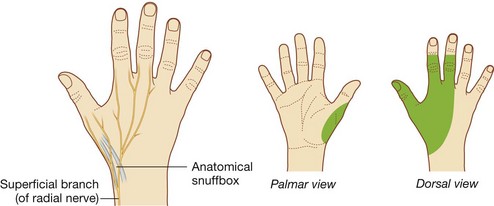Chapter 9 Movement and postural disturbances in adolescence
Case 9.1
Extension of the forearm, hand and digits are affected.
The area of sensory loss is usually limited to the area depicted in Figure 9.1. However, there is much overlap between nerves across dermatomes, and sometimes the area of sensory loss is much smaller than you would expect (sometimes only a small area over the anatomical snuff box), considering the extensive cutaneous distribution of the radial nerve.

Figure 9.1 Distribution of radial nerve in the hand
(Source: Drake R, Vogl A, Mitchell A. Gray’s Anatomy for Students [2nd edn]. Philadelphia: Churchill Livingstone; 2010:773, Fig 7.112)
Case 9.2
Females between ages 12–16 are 10 times more likely to develop Adolescent idiopathic scoliosis than males.[1, 2, 3]
Cobb-Lippman method and Risser-Ferguson method.
 On an AP radiograph, identify the ‘end vertebrae’: the vertebrae at the upper and lower limits of the scoliotic curve with maximal tilt toward the concave side of the curve.
On an AP radiograph, identify the ‘end vertebrae’: the vertebrae at the upper and lower limits of the scoliotic curve with maximal tilt toward the concave side of the curve. Draw lines along the superior border of the upper end-vertebra and at the inferior border of the lower end-vertebra. The horizontal angle formed by the intersection of the two perpendicular lines is the Cobb angle, indicating the degree of the scoliosis.
Draw lines along the superior border of the upper end-vertebra and at the inferior border of the lower end-vertebra. The horizontal angle formed by the intersection of the two perpendicular lines is the Cobb angle, indicating the degree of the scoliosis. However, in minor scoliotic curves the lines will intersect off the film, therefore draw a perpendicular line from each of the original lines. The vertical angle formed by the intersection of these two perpendicular lines will also produce the Cobb angle.
However, in minor scoliotic curves the lines will intersect off the film, therefore draw a perpendicular line from each of the original lines. The vertical angle formed by the intersection of these two perpendicular lines will also produce the Cobb angle.Case 9.3
| Possible diagnosis | Justification |
|---|---|
| Postural Kyphosis | Hyperkyphotic thoracic spine due to its flexibility. Excessive activity, hunched posture, back pain |
| Scheuermann’s disease | Male, hyperkyphotic thoracic spine, mild localised back pain, height above normal for age |
| Previous laminectomy | Structural deformity due to surgical intervention, especially prior to skeletal maturity |
| Congenital kyphosis (type II) | Failure of segmentation leads to excessively round thoracic kyphosis, back pain, compensatory lumbar hyperlordosis |
| Neurofibromatosis | Hyperkyphosis, scoliosis, progressive back pain |
| Ankylosing spondylitis | Male, thoracic kyphosis, low back pain exacerbated with activity |
Stay updated, free articles. Join our Telegram channel

Full access? Get Clinical Tree










